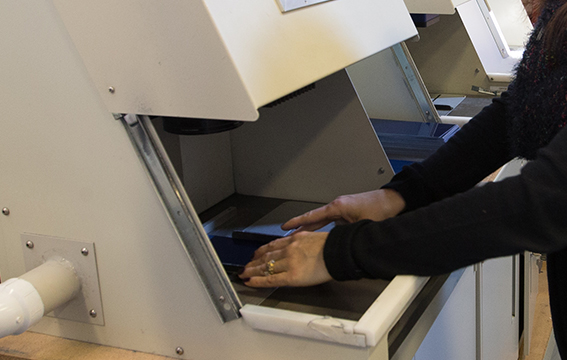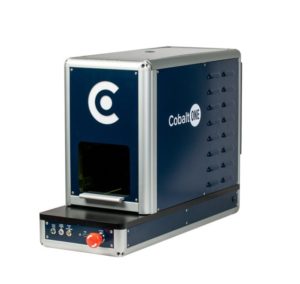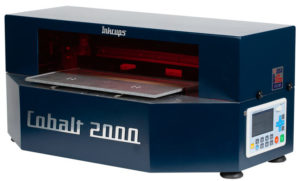- Equipment
- Inks & Supplies
- Services
- Applications
- Tagless
- Resources
- About Us
- Contact Us

The pad printing process transfers a 2D design onto a 3D product by running a loaded ink cup over an etched plate which transfers the image to a pad then to the product. One of the first steps in the process is etching the plate. Plates can be etched by either fiber laser or CO2 laser depending on your application.
The plate itself is one of the most important components of the process as it delivers the crisp image. In a recent blog post we explored Which Photopolymer Plate is Best for my Tagless Application. For more information on the numerous other options of pad printing plates we offer, reference here.
When deciding between the two systems there are three main differences:
Fiber lasers consist of a diode bar. This diode bar heats up during the process and after about 10,000 hours of use it can warp. Once the diode bar has warped, it is no longer useable. A replacement diode bar is a costly repeat purchase.
The spot size of a fiber laser is fine and able to produce highly detailed graphics.
Fiber lasers have wavelengths that are easily absorbed by metals.
CO2, commonly known as Carbon Dioxide laser require very little maintenance. It can be expected to use CO2 lasers for up to 70,000 hours with no maintenance required.
The wavelength of a CO2 laser compared to the wavelength of a fiber laser is ten times larger. Due to this, a CO2 laser is better for larger, less detailed designs.
A CO2 laser beam favors organic materials as the wavelengths are easily absorbed by wood, plastics, glass, textiles, rubber, and paper.
After reflecting on all this information it is now time to ask yourself the following questions to get a better idea of which laser is best for your application:
For an in-depth exploration of fiber lasers or CO2 lasers follow this blog post with another article, Fiber and Carbon Dioxide (CO2) Laser Technology.
Inkcups offers and supports two different laser plate-makers: CobaltONE and Cobalt 2000. Each machine allows the operator to etch plates directly using computer-to-plate technology. As previously discussed, depending on your application there are fiber and CO2 lasers to chose from.
 The CobaltONE fiber laser etching machine is a tabletop, compact unit housing all parts of laser plate-etching process in one place. Due to the nature of fiber lasers it offers the ability to etch small dot size resulting in a sharp image. This machine can etch images in a mere five minutes, yielding a plate that can be used up to 30,000 impressions.
The CobaltONE fiber laser etching machine is a tabletop, compact unit housing all parts of laser plate-etching process in one place. Due to the nature of fiber lasers it offers the ability to etch small dot size resulting in a sharp image. This machine can etch images in a mere five minutes, yielding a plate that can be used up to 30,000 impressions.
Pair your CobaltONE with a RX4 to filter 99.7% of particles from the air to keep your laser plate-maker clean, free of dust and debris.
 The Cobalt 2000 pad printing plate maker was created with both small and large printing facilities in mind as an affordable option. Pair your Colbalt 2000 with DuraLaze® laser plate material for graphics of the finer nature.
The Cobalt 2000 pad printing plate maker was created with both small and large printing facilities in mind as an affordable option. Pair your Colbalt 2000 with DuraLaze® laser plate material for graphics of the finer nature.
The Cobalt 2000 will fit into your work space whether it be on a work bench or production floor.
Inkcups always has your back. For those who do not wish to venture into plate making in-house, we offer the services for you. Our plate-making technicians put their seasoned skills to work to create fine-quality etched pad printing plates for you. The process is simple, quick, and convenient. Simply send in your artwork and sit back while we etch it for you. Prior to shipping it out we send a proof for your approval. Once we hear back with the stamp of approval, our U.S customers and some of our international locations can expect to have your plate(s) on your doorstep in 1-2 business days. To read more about this service, visit our Pad Printing Plate Etching Services page.
Back to Blog Home
Add Your Comment